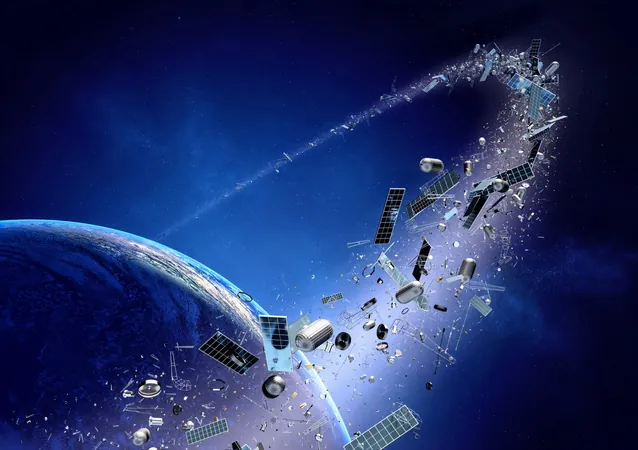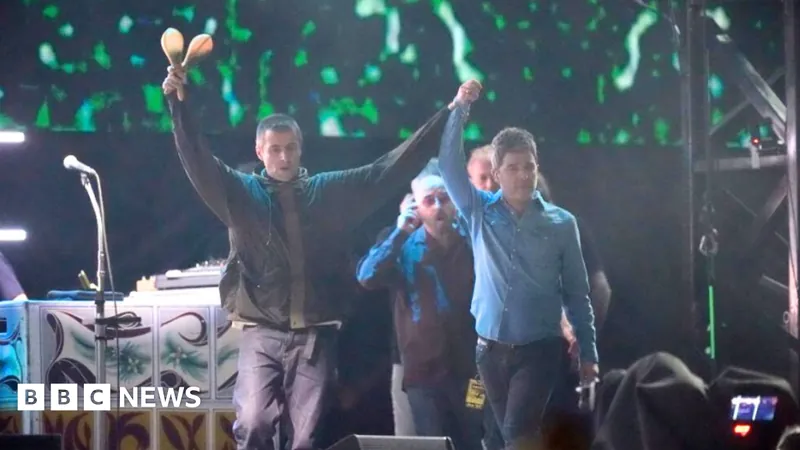
The Rising Menace of Space Junk: Are We Closer to Kessler Syndrome?
2025-01-05
Author: Ting
On October 19, a startling revelation emerged from the US Space Command: the Intelsat 33e satellite fragmented into roughly 20 pieces, contributing to the growing litter of space debris in Low Earth Orbit (LEO). The underlying cause of this breakup is still a mystery, but it has reignited urgent discussions regarding the alarming proliferation of space junk.
Low Earth Orbit: A Crucial Region for Satellites
Low Earth Orbit, which ranges from approximately 100 to 1,200 miles (160 to 2,000 kilometers) above Earth, serves as the primary domain for satellites. It is favored due to the lower launch costs and faster orbital periods—satellites can circle the planet in just about 90 minutes. This speed allows for frequent coverage of specific areas, which is essential for services like weather monitoring, global communications, and Earth observations. The International Space Station (ISS), a symbol of human capability in space, operates within LEO at around 250 miles (400 kilometers) above the surface.
The Kessler Syndrome Dilemma
The concept of Kessler Syndrome, introduced by NASA scientists in 1978, warns of catastrophic consequences from space debris collisions. As objects collide in orbit, they create more debris, leading to a cascading effect: a single collision can spark multiple subsequent collisions, resulting in a vast field of harmful fragments. Should this continue unchecked, low Earth orbit could become increasingly hazardous, effectively grounding all future satellite missions and disrupting essential technologies such as GPS and communication networks.
John L. Crassidis, an expert on space debris, mentioned, "If the probability of a collision is so great that we can’t put a satellite in space, then we’re in trouble." His warning highlights the critical need for measures to combat this escalating crisis.
The Alarming Growth of Space Junk
Currently, there are over 10,000 active satellites orbiting Earth, with Elon Musk’s Starlink network accounting for around 6,800 of these. Companies like SpaceX and Amazon plan to launch thousands more, significantly increasing collision risks. Since 1957, over 650 events of fragmentation have occurred, and actions such as the deliberate destruction of satellites, like Russia's military test in 2021 that created over 1,500 debris pieces, exacerbate the problem.
Bill Therien, CTO at ExoAnalytic Solutions, adds that the tracked debris varies in size from softball-sized fragments to larger objects comparable to car doors. This range complicates tracking efforts, particularly for the smaller debris that poses a significant threat to active missions.
Consequences and Risks of Space Debris
Overcrowded orbits jeopardize astronauts and essential technologies. The ISS has had to perform numerous evasive maneuvers to circumvent debris, with one recent close encounter occurring just 2.5 miles away. If satellite collisions occur or systems fail due to debris, services like GPS, broadband internet, and television could be severely disrupted, impacting modern life on a grand scale.
Steps Toward Mitigation
Efforts are underway to address the increasing threat of space debris. The European Space Agency (ESA) is collaborating with Swiss startup ClearSpace to develop technology capable of capturing and deorbiting inactive satellites. Additionally, novel technologies like drag sails are designed to hasten the descent of debris into Earth's atmosphere.
However, managing space junk remains a monumental challenge. The ESA estimates there are over 40,500 pieces of debris larger than 10 centimeters, along with millions of smaller fragments that current detection technologies struggle to identify.
A Call for Regulatory Frameworks
Experts assert that immediate international cooperation is essential to establish effective space regulations. The United Nations’ Pact for the Future aims to create frameworks for managing space debris, yet enforcement remains a pressing issue. Dr. Vishnu Reddy from the University of Arizona emphasizes that "the biggest concern is the lack of regulation," pointing out the need for industry guidelines and norms.
The Future of Space and Our Planet
As the number of satellites in Low Earth Orbit continues to rise, so does the threat of Kessler Syndrome—the terrifying chain reaction of collisions that could doom human endeavors in space. With over 10,000 satellites currently in orbit, the risks are more daunting than ever, endangering everything from exploration projects to vital satellite-dependent technologies.
To mitigate the catastrophic potential of space junk, proactive measures—ranging from innovative technology to stringent regulations—are urgently required. The only way to steer clear of the worst consequences of Kessler Syndrome lies in global collaboration, focused regulation, and timely intervention.
As we stand on the verge of a new frontier in space exploration, neglecting the looming risks of space debris could spell disaster for both current satellite operations and future endeavors. Will we take the necessary steps to secure the final frontier, or are we racing toward an irreversible catastrophe? The clock is ticking.
Stay informed about developments in space sustainability and satellite technology by subscribing to our newsletter, and join the conversation on safeguarding our orbital environment.


 Brasil (PT)
Brasil (PT)
 Canada (EN)
Canada (EN)
 Chile (ES)
Chile (ES)
 Česko (CS)
Česko (CS)
 대한민국 (KO)
대한민국 (KO)
 España (ES)
España (ES)
 France (FR)
France (FR)
 Hong Kong (EN)
Hong Kong (EN)
 Italia (IT)
Italia (IT)
 日本 (JA)
日本 (JA)
 Magyarország (HU)
Magyarország (HU)
 Norge (NO)
Norge (NO)
 Polska (PL)
Polska (PL)
 Schweiz (DE)
Schweiz (DE)
 Singapore (EN)
Singapore (EN)
 Sverige (SV)
Sverige (SV)
 Suomi (FI)
Suomi (FI)
 Türkiye (TR)
Türkiye (TR)
 الإمارات العربية المتحدة (AR)
الإمارات العربية المتحدة (AR)